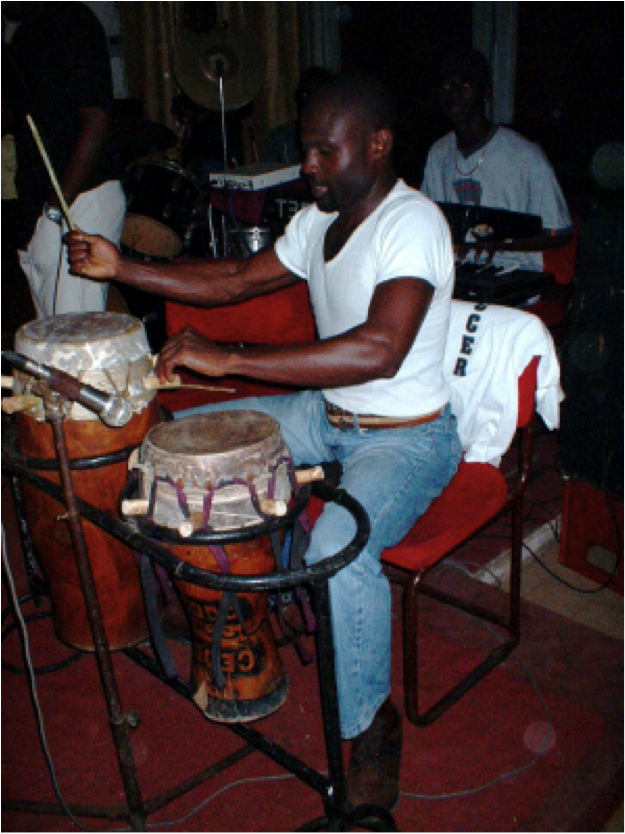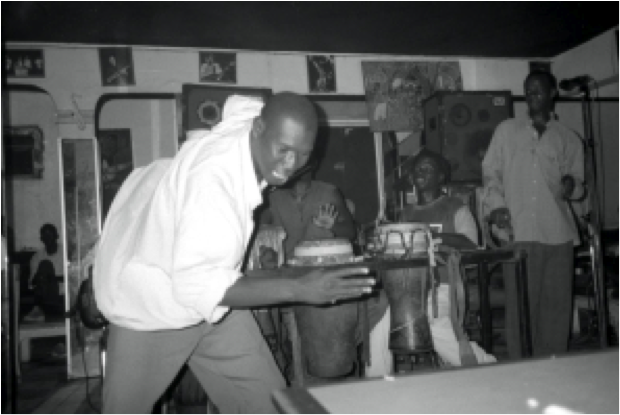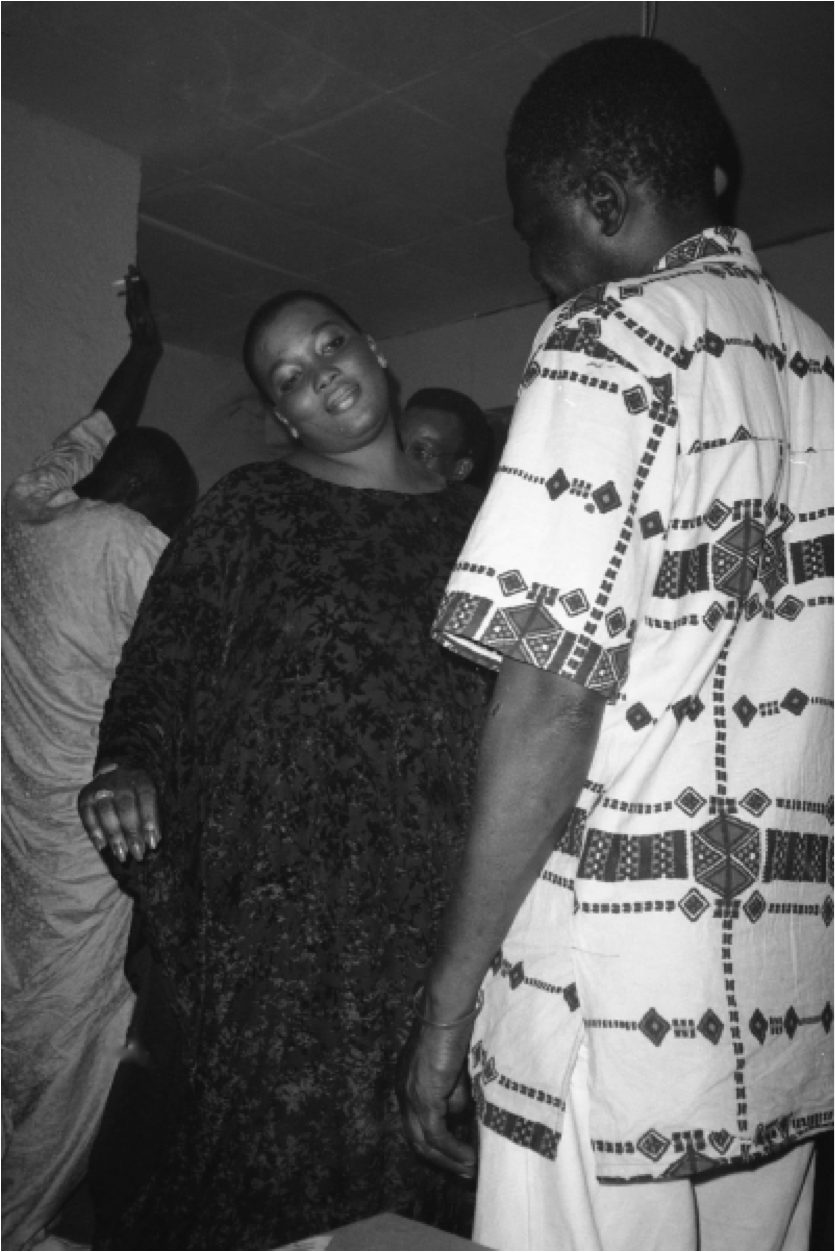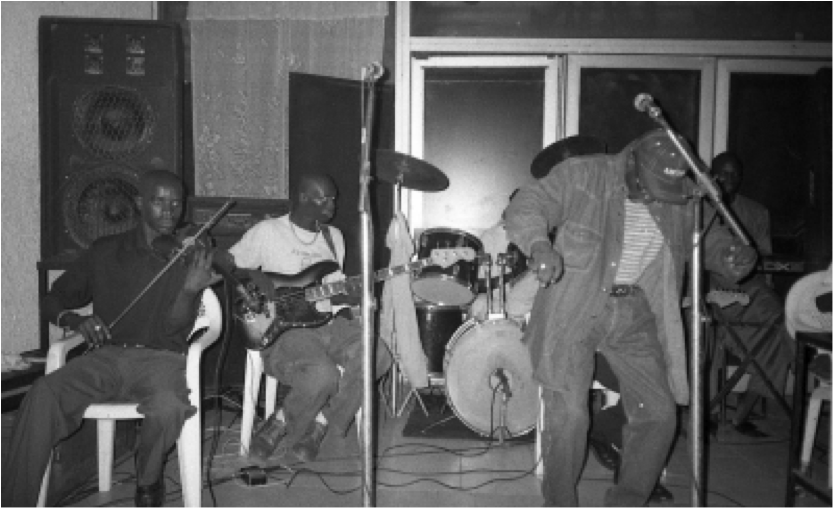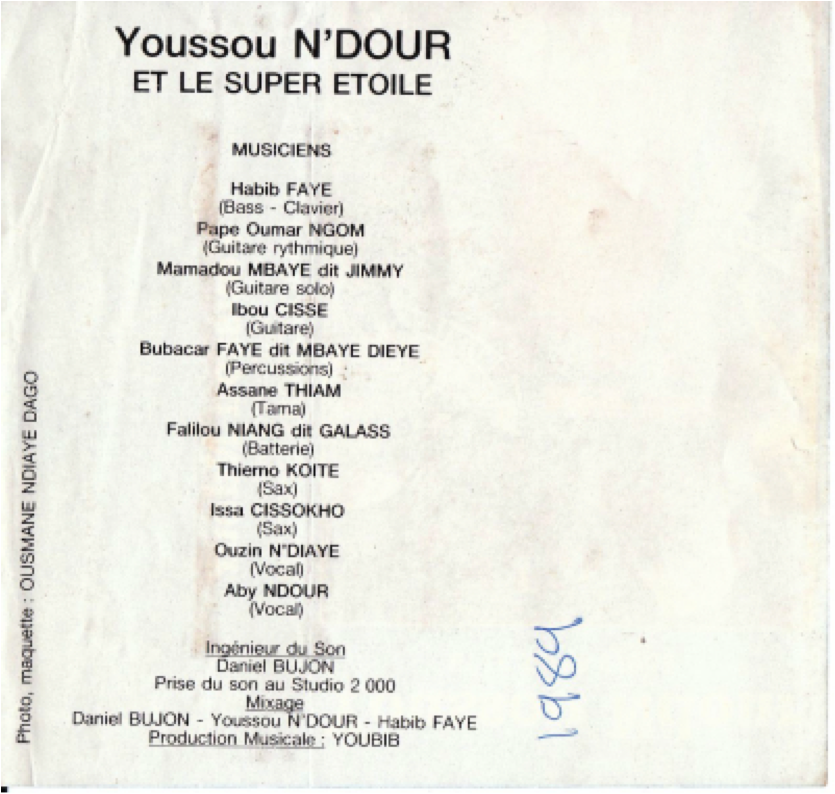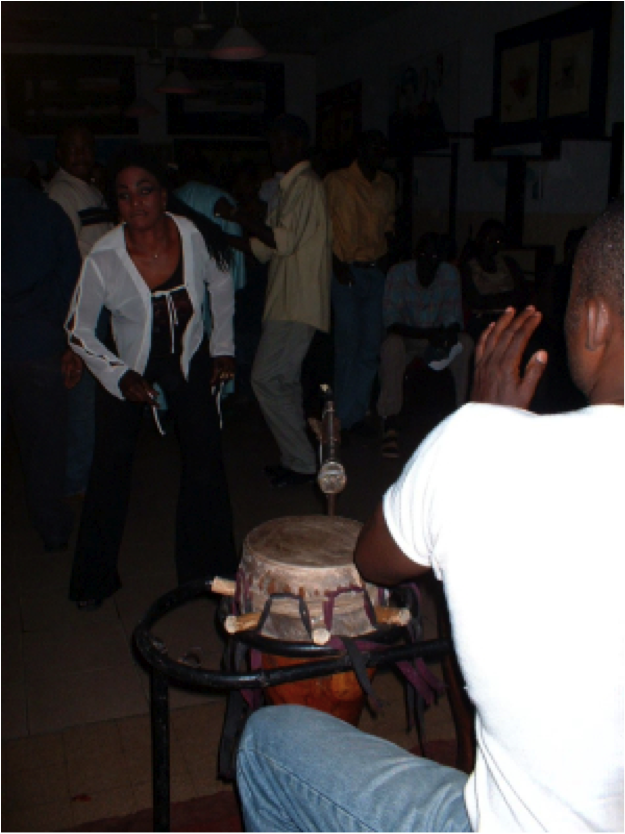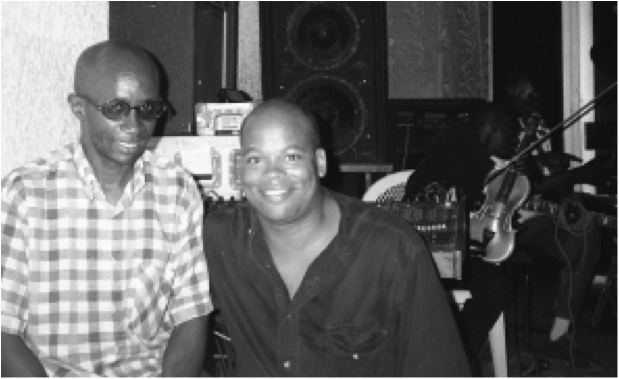Producer Simon Rentner sat down with Timothy Mangin to discuss Youssou N'Dour, Sabar Drumming, and how Mangin's experiences in Senegal informed his studies. Timothy Mangin, is a PhD candidate in ethnomusicology at Columbia University where he studies West African and African diasporic popular musics and is finishing his dissertation on mbalax. In 2000 he was a performance instructor for Jazz and Western Art Music at the National School of the Arts in Dakar, Senegal.
Simon Rentner: Thanks so much for taking the time to speak with Afropop. Let’s start off with—What is mbalax?
Timothy Mangin: Mbalax is really distinct to Senegal. It's based on the sabar—a very old and ancient music, but one that has long been cosmopolitan. In Senegambia, among the many ethnic groups were the Wolof, one of the largest ethnic groups in the region who were known for—and survived because of—their affinity for borrowing and including the cultural practices of many other groups in the region. Among these practices was the dance and drumming music, the sabar, a music that included musical styles from other groups. And the fundamental accompanying rhythmic pattern in sabar drumming is called mbalax, the rhythm that has become the sound of urban popular dance music in Senegal today.
S.R.: Is sabar music, in many respects, a modern music because it is cosmopolitan? You have all of these influences coming back and forth…
T.M.: Right. For a long time, a lot of different people contributed to the sound of sabar. Sabar was a dance music played by Griots on the drums. Griots were the dancers, best singers, and historians. Griots were a special caste group responsible for gathering information in the region, and communicating that to the rest of the people in the community. Griots also traveled a lot. They traveled along with the kings and rulers. They traveled with the religious leaders and the marabous—the religious teachers—when they went to places like the Middle East on the hajj. So, when these travelers returned to Senegal, the Griots told all the stories of what happened to the rulers, marabous, and the sheikhs (another term for religious leader and teacher) on their journeys including the introduction to new teachings they received abroad. The griots shared their experiences and influences with people in the villages and told them what was going on in the wider world.
Sabar Drummer
S.R.: And this was pre-Colonial era? How far back are we talking?
T.M.: It goes way back. Islam came into Senegal in the 10th century. Many of the old Griot stories that we hear are about aristocrats and clerisy from Senegambia traveling abroad and coming back in the 18thcentury and the 19th century. Most famous are the ones about Sheikh Umar Tal, a cleric who went on hajj to Mecca where he met the religious leaders of his order, the Tijaniyya, who bestowed upon him the title of xalifa or leader of all Tijani south of the Sahara. Then Tal came back to West Africa and traveled throughout the region. He set up a school in Senegal. He started teaching there for 10 years and did a lot of writing, which is still revered today. However, some local marabous and other traditional leaders in the area didn't like his teachings, orthodoxy, and ability to attract a lot disciples and congregants, so they attacked him. He retaliated and was particularly angry with how traditional leaders enslaved Muslims. One of the reasons Tal was popular was because if you were a Muslim living in his territory you were protected against enslavement from other Muslim and traditional rulers. Tal was a firm believer in the Islamic prohibition of Muslims enslaving other Muslims. Islam provided a counter way of life and protection against to the traditional aristocracy who sometimes pillaged villages and settlements for slaves to meet the European demand for the transatlantic slave trade. So, Islam, at that point, was one way different ethnic groups in the Greater Senegambian Region protected themselves against enslavement and pillaging. Islam was another cosmopolitan formation; a religion and way of life introduced from abroad that took on a distinct character in Senegal. Griots eventually began to praise not only kings and royalty but also African marabouts. It's another transnational formation.
S.R.: How does this all tie in with mbalax?
T.M.: Griots praised heroes and that included both traditional leaders and marabout warriors who fought the French. As praise singers and musicians, Griots performed a lot of sabar, a drumming music that includes the accompanying rhythm called mbalax. Mbalax is kind of like the heart of sabar; it's the rhythm that you're really going to feel, it’s the groove that you're going to dance to. It's something that takes you inside the music—that's mbalax. And the griots are the ones drumming and providing the music but also a lot more. As griots travel the countryside they pick up new rhythms and experiences that they put into the music.
Griots also played an important role in negotiating social conflict between the royalty, clerisy, and commoners. But it was complicated. Before Islam, the Griots were the principle advisors to the kings. Then, with the growth of Islam, marabouts began to advise the aristocracy and assist with jurisprudence based on Islam. This intruded on the Griots’ historical advisory role. At first, there was a tension between the marabouts and Griots and then, gradually, the Griots started converting to Islam along with the rest of the population. And that's one story.
S.R.: When did the French come in?
T.M.: The Portuguese came in the mid-15th Century and set up trading stations along the coast and the mouths of the Senegal and Casamance rivers. By the 17th Century, the Dutch and French had a strong presence along on the coast. The French built the fort, Saint-Louis (named after King Louis XIII), and then other outposts along the coast that were actually extensions of the France Métropole (European mainland). The Dutch settled for a while on an island the Portuguese had called La Palma, which the Dutch renamed Gorée. During the 18th Century, France and Britain fought over these outposts, with France gaining control over most of them. In the 19th Century, the French conducted their business from these coastal outposts and relied on intermediaries to facilitate trade with the Africans in the interior. These outposts became experiments of the French civilizing mission. Saint-Louis and Gorée became the first communes, territories where all of its residents were granted the same citizenship rights as those living in the French Métropole.
These French outposts became similar to French cities with their adoption of European political structures, but different due to their diverse populations of Africans, Arabs, French colonials, and a class of métis (people of mixed African and European descent). A certain kind of coastal African cosmopolitanism developed since the citizens in the communes had same rights as the people living in France, as opposed to the Africans living in the interior who did not have these rights.
Dancing to mbalax at Dieuf Dieul show
S.R.: You have this mixture that dates back centuries, which is fascinating, so you can also look at sabar music as extremely advanced because it is filtering all of these influences.
T.M.: Right. Sabar was in the countryside and then in the communes, particularly in the African sections inside the cities. In Dakar, one of the ways Africans made their presence known and asserted who they were as a people was to play the drums, which did not go over well with the French colonials.
One way the French and métis sought to marginalize the Africans who were asserting their presence through black politics and cultural practices (e.g., drumming) was to take advantage of a bubonic plague epidemic. When a plague broke out in the early 1910s, the French burned many of the wooden African homes and moved the Africans into a northern section of the city called the medina. The French remained concentrated in the lower section called the plateau. The medina became the heart of Dakar where a lot of the traditional practices survived and remained strong over the decades. This is the neighborhood where Youssou N’Dour and members of his band grew up. It was also where the Miami nightclub was located. Then, in the 1930s/1940s, a couple of major events happened: Negritude (blackness) was created in Paris by Leopold Senghor, Amie Césaire and other black students and artists living in Paris. Negritude was a humanist movement aimed at portraying positive images of blackness through art and literature such as the influential journal, Presence Africaine. Jazz was the soundtrack to the movement.
Then World War II began, and live jazz was brought to Senegal by American troops stationed in Dakar who removed the Vichy government. World War II also helped develop a media infrastructure, particularly radio. Senegalese start hearing the sounds and music from the United States (via Voice of America Radio) and from France. Jazz, the dance music of the colonials, was also the favored music of Africans who also listened Afro-cuban and other Latin musics. Among the U.S. troops in Senegal were African American soldiers who the Senegalese were anxious to meet. Many Senegalese wanted to see and hear the people responsible for creating this modern-sounding music that they had been listening to and enjoying. So, African Americans started getting together and shared their knowledge of jazz and life abroad with the Senegalese.
Some Senegalese formed jazz bands that played U.S.-style jazz, then added Afro-cuban and Latin jazz. These groups were the foundation for the early mbalax groups who added the sabar drums and rhythms. That lead to the mbalax we know today, popular urban dance music created by Dakaroise fusing the sabar with African pop bands.
In Dakar’s early days, Griots had long lived in an area called the tund (where the Novotel is today). At first, the colonials attempted to restrict the playing of traditional music. Then those rules were eased and the sabar drumming increased. So, in 1950s Dakar there was sabar drumming occurring in the city along with modern jazz bands playing Afro-Cuban, Latin, and French variété musics. The musicians playing these modern musics were very cosmopolitan and made decent wages and traveling throughout French West Africa. As the capital of the FWA, Dakar was a hot spot, and the center for the debate on how to gain independence. With independence in 1960, the nightclubs had a new energy spurred by Africans playing a lot of jazz, Afro-Cuban, and early R & B music which symbolized modernity and connected Senegalese to freedom movements in Africa and the U.S. For example, they played modern Congolese music, especially the song "Independence Cha Cha."
Salsa-mbalax dancers
S.R.: And Congolese music comes from where?
T.M.: It comes from the Belgian Congo. Central Africa and modern Congolese music had a lot of Afro-Cuban rhythms in it because the Congolese were listening to a lot Cuban and other Latin music that they transformed into their own style. You have these bands in Dakar and they're playing all of these musics from the Congo, but they're also playing Nigerian and Ghanaian highlife. And they're playing national musics from other African countries. And people in the dance clubs are saying, "We want our own kind of music."
At that time, Senegalese urban dance bands used mostly congas and the timbales. Then drummers stared playing the sabar rhythms on the congas and the timbales and people started wearing more traditional clothing.
Then musicians brought in the sabar drums and used them for the mbalax rhythms. Evenings became a series of sets focused on musical styles such as a jazz set, then an Afro-Cuban set, and ending with a traditional set. The traditional set included a lot of sabar and traditional singing collectively called folklore. Then they started mixing folklore and modern musics together. Most famously, this happened at the Miami Night Club in the medina but it was also happening in other places such as in Gambia where it drew the attention of musicians, including a young Youssou N'Dour, who went down south to Banjul with friends to sing and play. When N’Dour came back to Dakar he, joins the house band at the Miami Club. He later takes the use of traditional rhythms a step further. He used the rhythms of the sabar drums and he puts them in the keyboards and in the guitars and he mixes those rhythms with Afro-Cuban and the jazz that they're doing and he starts calling the music mbalax music.
S.R.: How innovative was Youssou N'Dour? I mean, was he alone in conceptualizing sabar drum arrangements on these other instruments? How much of a breakthrough was this?
T.M.: Well, the breakthrough was taking the rhythms and putting it on the Western instruments—the keyboard and the guitar. There were other people who were using the patterns on the congas and some of the other percussion, or bringing in the drums, or even bringing in the tama drum into the club. So, that part of it wasn't new, but when you started taking those rhythms and some of the ideas from the sabar and spreading it out throughout the group, that was kind of new.
S.R.: And it's kind of a simple concept, really, but it was revolutionary.
T.M.: Right, but it was difficult to make it really work because there's a different kind of feel to the music of sabar and that of jazz and Afro-Cuban music. They're two different kind of musical systems.
They have roots in Africa, but when a lot of African music went to the States and it came back, it didn't have exactly the same feel as African music. There were similarities but also differences. A lot of the musicians I talked to said that jazz and R & B and Cuban music was in the blood, and I asked, "What do you mean by 'in the blood'?"
They said it's because they grew up hearing it. It was part of their life. They grew up listening to James Brown and Otis Redding, but they also were listening to guys like Tino Rossi and Johnny Hallyday from France and other cats, too. So, there was a little bit of a rock influence, too – just a little bit of that, that's hitting them, as well.
Doudou Sow & Number One Plus
S.R.: Is Youssou N'Dour a big African star or the biggest African star?
T.M.: [laughter] He's the biggest African star. You mean in Senegal?
S.R.: In Senegal, in the world – perhaps the continent. You tell me.
T.M.: Well, you have Youssou N'Dour, you have Salif Keita and there's Cheikh Lo, Ismael Lo and those are pretty large stars. Manu Dibango was a large star when he did "Soul Makossa" as well. And, of course, right now Youssou N'Dour is probably the biggest star, especially since he won the Grammy for Egypt.
S.R.: So, how many Africans are listening to his music?
T.M.: I don't know. [laughter] But I can tell you, in Senegal, people say Youssou N'Dour could be president if he wants to be. He's a social commentator. Youssou grew up in a house of Griots. His mom was a Griot and his father was a civil servant; I think he was a mechanic actually. But Youssou was always drawn to music so he learned the art of Griot story telling and what they call animation – how to animate an audience, how to get an audience involved in what you're doing, and that's a really critical skill you have to have in order to be a good mbalax performer.
Youssou calls himself a modern Griot. He sings about religion, he sings about moral values, he sings about respecting the elders and respecting the ancestors. He sings about how Senegalese need to keep their minds and their hearts open to the rest of the world. He's really well respected, and this goes back to his early days and one of is seminal recordings, “Set”, which means to clean, or to be cleaned.
When you listen to “Set”--it's mostly in Wolof but there's some English in it–he talks about how the Russians, Americans, and all these other foreign powers have problems that will be solved one day. Then he talks about Senegalese and their problems – he's saying that Senegalese are just as important as all these other cats and all these other people, all of us, need to work on civil rights and human rights.
S.R.: Did Youssou N'Dour face any resistance – death threats – because he is such a political figure, too? He's a moralizer. Did he experience resistance with any of his messages?
T.M.: Oh, yeah. He gets resistance all the time. That's the big thing about Youssou: He's always trying to stretch the boundaries. He's like a jazz artist: taking it “out.” N’Dour takes it out a little further and further. He's always introducing new sounds to mbalax and new ways to approach the rhythm or the music, but he doesn't get death threats or anything like that. What happens is he’ll usually work on music inside his night club, Thiossane, and he'll release something locally. Then he'll take some of the tracks and then he'll work on it abroad in France or another country and come back with another cassette or CD. The last big experiment was Joko – that was a big CD for him where he did a lot of collaborations with other artists in the West. It was heavily produced, and Senegalese weren't really that thrilled with it. It was supposed to be Youssou's big crossover album to get a huge pop market but local response was tepid. There wasn’t enough sabar percussion.
Set k7
Set k7
So he went into the studio and recorded a cassette called Rew Mi because it was really important for him to maintain his Senegalese audience. And when he did Rew Mi, he added a lot of what we call "mbalax pur et dur" – mbalax pure and strong, meaning he used a lot of percussion because he wanted to connect back with the audience.
Mbalax dancer at Ceddo show
S.R.: How much do you connect the movement of mbalax music with Senegal's independence?
T.M.: Oh, it was real big part of the independence movement. Like I said, there were other national Afropop musics that were on the scene at that time. Senegal didn't have its own sound. What's the sound of Senegalese independence? That was a critical concern for audiences. With the creation of mbalax, there was that critical sound. It was something that was worked out in the night clubs. When you had the sabar drums working with all these other instruments, you also had people dancing to it. So, you're in a night club, people are playing the sabar drums and they're doing the dances, many of which were women’s dances, but in the nightclub, in this very modern space, men dance along to sabar rhythms usually reserved for women and women dance to rhythms that were once only for men. So, you had this kind of gender reconfiguration going while newly independent Senegalese are creating their modern identities. A lot of this early patronage came from the new public servants and businessmen. When Senghor was in office, he created a large public servant sector and these guys are thinking of themselves as very modern. And the music that they listened to was jazz and Afro-Cuban music; they considered that very modern music because they wanted to be modern.
S.R.: What jazz are we talking about? You didn't mention any specific jazz artists that the Senegalese were listening to.
T.M.: They were listening to Miles Davis and John Coltrane, Herbie Hancock – people like that. Then when Youssou was doing his thing, that was considered traditional music and they really weren't that much into traditional music. I said, "Well, why weren't you into it?"
They said, "Well, we wanted to be modern."
And I said, "But you still went to the clubs?"
And they were like, "Yeah, we still went to the clubs! We wanted to have fun."
So, gradually the music appealed to this growing civil servant sector class who were becoming educated and associating themselves with modern citizens of the world. And they started to patronize the clubs and they were patronizing the musicians. Then you had the club Sahel, which was the first nightclub built specifically for mbalax bands. The house band was called the Sahel Orchestra, and their innovation was to bring in the trap drum set and add that to the mbalax sound.
Tim Mangin with Doudou
S.R.: Tell us more about the Afro-Cuban bands of the time.
T.M.: Well, the Cuban bands were – Well, things were all kind of mushing. [laughter] They're blending together at the time, but Orchestra Baobab had a strong Afro-Cuban influence. All those bands had a strong Afro-Cuban influence, but if you listen to a song like “Ndiaye” with Laye M’Boup, it's got some amazing Jimi Hendrix sounding lines in it, too, that will take you into the stratosphere.
Then it will kick in with some really tight sabar drumming. So, you start off with this Latin groove, then get this strong psychedelic Jimi Hendrix sound, then – boom – they hit you with sabar. And on top of that, you have this really hardcore, strong and beautiful sound. And when you hear Laye’s voice coming in, that's the classic traditional sound of the singer. A lot of the bands have a traditional singer and a modern singer, and Laye M’Boup was one of the first. People who worked with him and studied with him were singers like Thione Seck, who's one of the major mbalax stars today, and others. You can hear people like Khamdel Lo of Group Ceddo and how that linage is there. Of course, he didn't study with Laye because Laye died early, but that's the traditional singer sound. Then you also have someone who has more of a modern sound, and they're going to have more of that soul kind of voice to them. And Youssou N'Dour can go back and forth between those different voices, or he blends it together in a unique kind of way that makes things really, really happen for people, so that's really important, too, in the group.
What you need to remember is that people play these traditional sabar rhythms – the percussionists do – but they're always creating new rhythms, too. So, the accompanying drumming parts that you're going to hear with the ensembles, they're not always going to be older patterns and rhythms.
S.R.: Are they new bakks?
T.M.: Yeah, you can have a bakk, which is more like a composed rhythmic statement, but there's also the rhythms when they're combined together.
S.R.: So, the rhythm you gave me from Kaolack—the Kaolack rhythm?
T.M.: The Kaolack rhythm, exactly. So the Kaolack's a rhythm, but it’s also a dance and you can use it to transition to Ceebu gen and that's one of the major rhythms that you'll hear in modern mbalax music and modern Senegalese music. But to be clear, the Kaolack is actually polyrhythmic—a piece of multiple rhythms layered on top of each other. But in local everyday speak it’s called the Kaolack rhythm.
Tim and Doudou
S.R.: Tell me about your first experiences in Senegal.
T.M.: So, I get to Dakar and I'm living in HLMII when I first arrived. It's, like, in the middle of the night. I walk down these sandy streets and there's a group of guys in white, and they're singing a lot of xasaïd, or religious songs. There's dayirah singing, and goats are bleeting.
So, I end up at this house with this family and during the day, when the guys are out looking for work, sometimes I'm hanging out and I'm learning – I'm working on my Wolof with the ladies of the house who are still doing their household chores and stuff like that and, of course, they teach me a couple of sabar steps and sabar dances and stuff like that. But, anyway, to make a long story short, one of the guys that I meet in the neighborhood, takes me to the Sahel nightclub. At first, they wanted to go hear hip hop; they were hip hop heads and said, "The sabar is old stuff. We don't want to do the sabar."
But we go and it's Thione Seck, and he's singing. So, we go in and we meet some of his friends who are there. There's about six of us and we start dancing. We form, like, a circle between the six of us, and it's like all of a sudden that reticence to go and hear rap has disappeared – all of a sudden, people are just smiling and swaying and moving back and forth. At first, they're just kind of standing there, just swaying a little bit, and the rhythms are really hot and there's all this stuff that's going on. I'm just like, "Wow, this is really intense but no one really seems to be moving."
Then, all of a sudden, the tempo picks up and people start bending their knees and start getting down. Then, someone moves into the middle of the circle and they start doing, like, a – at first, I said, "That kind of looks like a modern-day Funky Chicken kind of thing." I'm standing there, and I'm trying to get my hips and my knees to move the same way that everybody else's is, but it's not happening the same way everybody else's is, and I'm hearing the music the wrong way. I'm thinking about how I hear it here in the States, which is like emphasizing the two and the four, and it's really more about the one and three. As soon as I stop thinking about that and stop thinking about "there has to be one" – like one, two, three, four; like you just always think about "there's got to be a one in music" – and just move my body along with the cycles and the rhythms and the patterns, I start dancing.
I start doing my own thing -- well, I mixed it a little bit with what was going on there – but when I started doing my own thing and fitting in, then I started to get inside the pocket, what they call "yaangy ci biir.” I was inside the music at that moment. I was still dancing very much like an American, but I was inside the pocket.
S.R.: So, what did that feel like?
T.M.: Well, you know, you're dancing in a circle and you're smiling and you're looking at your friends and everyone's communicating on the dance floor with each other and no one's touching each other. Every time someone moves into the circle, you kind of answer what they're doing with a body movement of your own. You take what they do and then you elaborate on it. So, you're communicating through your body, so it's a whole type communication that's going on through the body in a whole different kind of way.
S.R.: Was that the moment you were hooked and said, "I just have to write about this. This is what I have to do"?
T.M.: Well, when I started dancing, I started to understand what the music was about. You kind of have to dance to the music to understand. For me, it was dancing to the music to understand what I was hearing because the polyrhythms in mbalax are very different from all the other West African dance musics. It's very different from highlife, from juju and from fuji music, or from Afrobeat for that matter.
S.R.: Is that because it's on the three?
T.M.: Well, there's a different way of feeling the music, and it comes from a Senegambian tradition, whereas fuji and juju are highlife and rumba and those kinds of musics. So, there's a lot of diversity in West Africa and you can hear it in that kind of sound. Thione Seck, though—that was pretty amazing being at the concert and listening to him singing, because he has that traditional voice but he's also been influenced by the Bollywood films, as well. So, he has somewhat of a nasal kind of tone to it.
Thione’s family goes all the way back to the King Lat Dior, who was one of the last aristocratic rulers in Senegal. He has this blood genealogy as a Griot that goes all the way back, or as a géwël that goes all the way back. So, when he starts singing about the history of Senegal in these modern pieces, people can also locate their history in what he's singing.
S.R.: What is your favorite Thione Seck tune?
T.M.: “Yen bi,” because it's about finding your way and it's about honoring your grandparents and your elders. It’s also about praising God and having a path. So, it touches on the spiritual qualities on life in Senegal, too, in the lyrics.
The way it opens up with his voice soaring over the percussion—he has a really strong mbalax sound in his music, and you can hear a lot of tension.
S.R.: There's a drama and it builds, is that what you're saying?
T.M.: When his voice comes soaring in and it's really high and it's really strong and distinct, and it's coming over this really clean but really dense polyrhythm. Then you can dance -- like in the two, one, two – or you can dance like one, two, three, one, two, three – or you can go one, two. So, you can experience it in two different kinds of feels, or however you want to feel. It's just a really strong piece.
S.R.: Beautiful. Youssou N'Dour's tune "Independence" – I imagine that's about Senegal's independence, yes?
T.M.: Yes. OK, so, with “Independence,” you hear those strong Cuban horn lines. So, you have the retention of those Cuban horn lines before Youssou N'Dour, and a lot of the artists turned over to using keyboards and synthesized sounds of the horns. In "Yenbi", you're going to hear that sound of the horns, as well, so that's like an Afro-Cuban retention that you're going to hear in "Yenbi." Then, in "Independence," you have that really strong, Cuban horn line that's in there. There's a great dialogue going back and forth between Youssou and the singers.
It's almost like when the Griots at the penc at the center of town and he's at the tree and he's telling the news about the something that's going on. That's called the "penc." And it's like Youssou's communicating to the rest of the people about independence and the benefits of independence.
S.R.: Because mbalax comes from the Griots and the Griots act as politicians, public intellectuals spreading morals to the rest of the world, learning from the rest of the Griots, is there a particular lyric in an mbalax tune, a strong moral message that really just resonated with you as a way of approaching life?
T.M.: I guess it'd be the lyrics in "Soiree Sénégalaise" by Salam Diallo. Where he opens up with tassu, which the Senegalese say this is where rap comes from. It's the original rap, so you have to realize that rap, in general, is very old and jazz is new. So, Salam Diallo is a mixture of different ethnic groups and one of the things about mbalax, too, is that in the city, even though the Griot is really important, it's part of a caste system. The music represents also a way for people to transcend these caste groupings, to create new identities as Dakarois.
That's going beyond the restrictions that you have, whether that's being gëër, géwël, or some other lower caste kind of thing, too. So, in "Soiree Senegelaise", he's using tassu, which is really an ancient form of rap, to praise. He's doing a lot of praising. He's praising the places and the people that constitute modern-day Senegal. The beaches, the nightclubs, the major mbalax players, the drums are listed in the song. Then he talks about honoring your mother and your parents. It's a wild tune, and it also has a lot of dancing to it. Salam Diallo is known as a dancer. He's known more as a tassu cat and a dancer, as opposed to being a singer.
Tim Mangin with mbalax singer Pape Niang
S.R.: How many dances, formal or not formal, are in mbalax?
T.M.: They change every week. [Laughter.] There are just tons and tons of dances. When you got to a soiree Senegelaise, people are going to create their own new dances, and they're going to copy the dances that they see in video clips – what they call music clips – on television, so they imitate those dances. And they elaborate it and they do their own thing. So, when you're in a nightclub and you're dancing to this, that's an opportunity to get out there and show your thing. So, the band's playing and there are drummers – there are usually two to four drummers. Most of the time, there's two to three. So, there's a drummer there and, at a certain part of the song, he'll look out and you'll see someone come up right in front of the drum. They'll look at the drummer, and they'll smile, and there's going to be a dialogue between a single dancer and the drummer, just like you're going to have at a sabar event.
S.R.: So, are we talking about dozens of dances, hundreds of dances, thousands of dances?
T.M.: In a street sabar, you have a set number of dances. So, when you go to an event, if you go to a tànnibéer, then you're going to be chanting and there's going to be a drumming intro where they praise the drums and Allah, or Bamba. And then they introduce that this event is going to happen. Then, you go through a set. There's a set for that. I guess there's about 12 dances for traditional sabar. But, when you go nightclubbing, everyone's got dances they're doing what they've seen on the video clips and the music clips, and things that they've made up hanging out in the house. So, it's going to be a lot more than those.
The other thing to understand is that there are different styles of mbalax. There is Afro mbalax. There's salsa mbalax. There's mbalax “pur et dur.” When you have all these different genres, that's a huge cosmopolitan formation right there and it gives life to the music.
So, during the night, at a Youssou N'Dour concert, for example, he'll do mbalax pur et dur to bring the audience in and get them really going and really smiling. Then, he'll take them out and introduce new sounds and then he'll bring them back in with a lot more of that percussive style. And then there's going to be some salsa mbalax, too, and that takes people to their parents' generation, that independence era when salsa mbalax was more the sound of mbalax.
S.R.: What is the thesis of your current essay?
T.M.: Mbalax is very specific to Senegal. It wouldn't happen in any other place in the world. Yet, it's dependent on a lot of musics from other places in the world, such as jazz, hip hop now, R & B, soul and things like rock ‘n’ roll. Senegalese are very aware of what's going on in different places and, since there's a large population of Senegalese in different cities around the world, like Paris and New York and Baltimore and Atlanta and different places in Europe, they bring those sounds back with them. Just like the sabar itself when they were taking different sounds from different ethnic groups and mixing it in with the Wolof aesthetic, that's the same thing that continually happens in mbalax today. That revitalization keeps the music alive and current for people.









